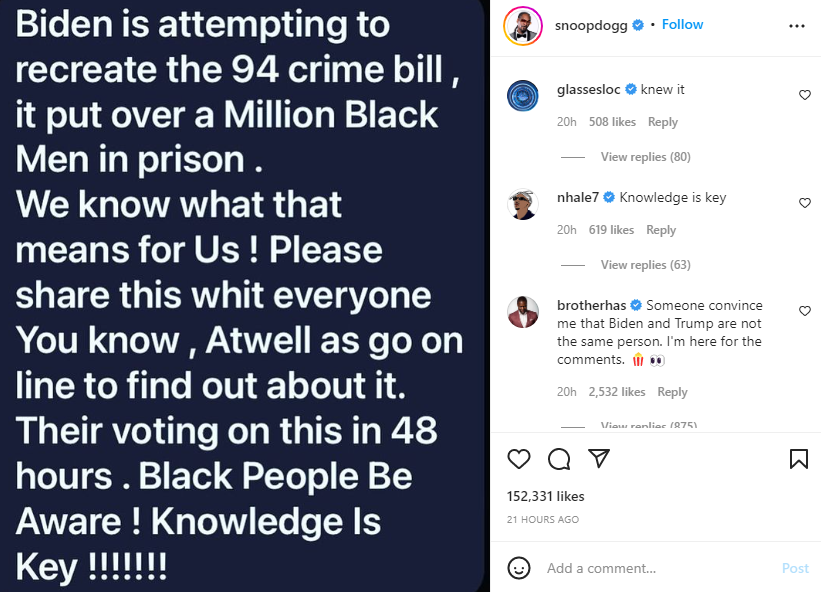
Did the 1994 crime bill put over a million Black men in prison? No, that's not true: The Biden administration announced a plan in late July 2022 that, similar to the 1994 crime bill, would increase police funding and aim to crack down on crime.
However, there is no evidence that the 1994 crime bill alone led to the incarceration of more than a million Black men, and the scope of the Biden plan does not seem comparable to the 1994 crime bill.
The claim appeared in an Instagram post on July 27, 2022, that included a graphic that reads:
Biden is attempting to recreate the 94 crime bill , it put over a Million Black Men in prison .
We know what that means for Us ! Please share this whit everyone You know , Atwell as go on line to find out about it.
Their voting on this is 48 hours . Black People Be Aware ! Knowledge is Key !!!!!!!
This is how the post looked on Instagram at the time of writing:

(Source: Instagram screenshot taken on Thu Jul 28 14:33:06 2022 UTC)
The Biden administration released information about its Safer America Plan (archived here) on July 21, 2022. The fact sheet for the plan contained explanations of what the plan aimed to accomplish, including increased funding for police, harsher penalties for fentanyl trafficking, investment in crime prevention and more funding and policies to aid in gun control.
It is true that some of the Safer America Plan's proposed efforts echo allocations made in the 1994 crime bill, formally known as the Violent Crime Control and Law Enforcement Act of 1994 (a fact sheet for the 1994 crime bill can be found here). As the ACLU noted in a response to the announcement of the Biden plan, both the 1994 crime bill and the Biden plan have called for funding for an additional 100,000 police officers: In the case of the 1994 crime bill, it was a move that the ACLU said "resulted in massive over-policing and rampant rights violations in our communities." The ACLU also drew a parallel between the tough stance on drug offenses that occurred during the implementation of the 1994 crime bill (but originated two decades earlier) and the crackdown on fentanyl trafficking outlined in the Biden plan. And, as the NAACP Legal Defense Fund pointed out, Black people are shown to be disproportionately affected by policing and incarceration, which would most likely make them take the disproportionate brunt of any ill effects of the Biden plan.
However, there are notable differences between the 1994 crime bill and the Safer America Plan. The 1994 crime bill was touted as the largest crime bill in the country's history and contained 33 titles that ranged from the punitive measures described above to an act that was designed to curb violence against women. The scope of the Biden plan does not appear to compare to the 1994 crime bill. Additionally, although Biden loudly and proudly supported the 1994 crime bill, the Biden plan aims to reverse the effect of the crack cocaine and powder cocaine sentencing disparity, described in further detail below.
Analyses from the Brookings Institution and the Brennan Center for Justice explain that while the 1994 crime bill did significantly impact incarceration in the country, the bill alone was not directly responsible for mass incarceration. An explainer from Vox also reaches this conclusion. None of these analyses, nor other evidence, suggest that one million Black men were incarcerated as a result of the 1994 crime bill.
The 1994 crime bill was one of many laws that continued a trend already set by the federal government to take tougher punitive measures. Researchers seem to agree that such measures were made more blatantly discriminatory after the enactment of the Anti-Drug Abuse Act of 1986. The 1986 anti-drug bill led to a disparity between crack cocaine and powder cocaine sentencing, with crack cocaine carrying a much lower threshold for sentencing. It is generally accepted that the 1994 crime bill exacerbated the 1986 anti-drug bill's impact.
The 1994 crime bill dedicated billions to states to use for prison expansion. But research from the Council on Criminal Justice shows that while the state prisoner population continued to increase after the implementation of the 1994 crime bill, the state prisoner annual growth rate actually slowed despite the copious funding incentives provided by the 1994 crime bill. The Council on Criminal Justice resource says:
The rate of state prison growth slowed from about 7% annually in the years preceding the Crime Bill's incentive funding to less than 3% annually while such funding was available and during the years that followed.
The funding incentives did not drastically affect state sentencing and release policies.
Other Lead Stories fact checks related to the 1994 crime bill can be found here.

















